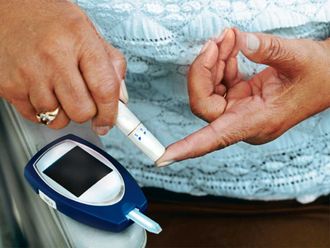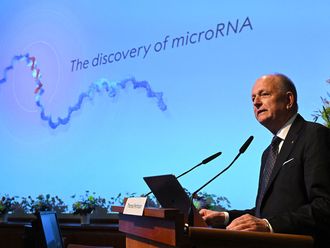
Calorie-counting is off the menu for slimmers who want to lose weight for good.
According to the world's largest diet study, the best way to lose weight is to eat as much as you like — as long as you choose the correct foods, which include cold pasta, meat and nuts.
Overweight children also get slimmer when their parents stick to high-protein, low-carb cooking, researchers say.
A £12-million (Dh69-million) study concluded that the calorie-counting methods Britons have favoured for two decades are wrong and the best way to stay slim is to eat unlimited amounts of the right foods.
They tested five diets and found that the most effective was a high-protein, low-Glycaemic Index (GI) regime, which includes lean meat, poultry, fish, eggs, pulses and nuts.
It is based on carbohydrates with a low GI, such as wholegrain bread, porridge and brown rice. These break down slowly during digestion, making dieters feel fuller for longer and stabilising blood sugar levels.
Cooled and cold foods take longer to digest so have a lower GI while cold pasta contains more resistant starch that delays digestion.
Solving the obesity riddle
Professor Arne Astrup, of the University of Copenhagen, said the findings could finally solve the obesity riddle. He said: "For many years we have been giving people in Europe the wrong advice about how to lose weight and avoid becoming obese. Calorie-counting hasn't worked and may have made the problem worse, because it didn't distinguish between different types of food."
The new diet composition is much more effective at helping people maintain a healthy weight. It has a slightly higher protein content and low-GI foods, and you can eat as much as you want. The six-month Danish study involved 772 European families, comprising 938 adults and 827 children, reports The New England Journal of Medicine.
The overweight and obese adults followed a traditional 800-calorie-a-day meal plan for eight weeks, losing an average of 11 kilos. They were allocated to one of five diets to see which was the most effective at keeping the weight off.
The nitty-gritty
The options were a low-protein, high-GI diet; a low-protein, low-GI diet; a high-protein, low-GI diet; a high-protein, high-GI diet; and a control group with no special instructions about GI foods. In the low-protein diets, protein comprised 13 per cent of energy consumed while in the high-protein diets, it represented 25 per cent.
High-GI foods are those scoring 70 or more on the GI — a scale of zero to 100 representing how quickly glucose is released into the bloodstream after eating.
Low-GI foods are those with a value of 55 or less.
The participants were given access to free foods suiting their diet plan from a university supermarket, with barcodes to ensure they were sticking to the appropriate meals.
Those on the high-protein, low-GI diet gained the least weight while those following the low-protein, high-GI diet put on the most — an average of two kilos.
Children also benefited, although they never specifically went on a diet. By the end of the study, the proportion who were overweight had fallen from almost half to 39 per cent.
According to researcher Dr Susan Jebb, head of nutrition and health research at the Medical Research Council Human Nutrition Research Centre: "It's essentially a low-fat diet, with a modest increase in protein that seems to make people feel fuller for longer. The low-GI foods give added value. If there is a single message to the public, it's about eating quality carbohydrates — not all carbs are the same."












